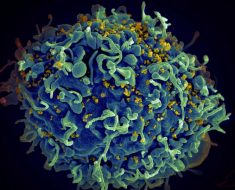Grief is a natural and inevitable part of being human. It’s how we process the loss of a loved one, relationship, pet or pregnancy. But for something that’s so commonly experienced, it’s inexplicably complex and can be difficult to define. That is until a woman named Lauren Hershel shared an analogy on Twitter that seemingly makes sense of it all.
It’s called the ‘ball in the box’ theory.
“After what has been a surprisingly okayish Christmas, I had a moment today in SuperStore,” she began. “Saw a lady who reminded me of my 92yo grandma, who even in the early stages of dementia, completely understood that my mum died. I thought I’d share the Ball in the Box analogy my Dr told me.”
It starts with a diagram of a box with a ball in it. There’s a big red ‘pain button’ sitting to one side of it too.
“In the beginning, the ball is huge,” she explained. “You can’t move the box without the ball hitting the pain button. It rattles around on its own in there and hits the button over and over. You can’t control it – it just keeps hurting. Sometimes it seems unrelenting.”
Gradually though, as time progresses, the ball gets smaller.
“It hits the button less and less but when it does, it hurts just as much,” she said, adding that this stage is “better because you can function day-to-day more easily.” However, occasionally the ball will hit the button when you least expect it.
“For most people, the ball never really goes away,” she said. “It might hit less and less and you have more time to recover between hits, unlike when the ball was still giant.”
Sure, Lauren’s diagram might be simple, but it clearly struck a chord with so many people – the post has since gone viral, racking up more than 12,000 likes and 5,800 retweets.
I am a nurse and lost my grandpa in a very bad way last year and this is one of the first things I’ve read that completely matches my grief…” one person responded.
“I think you did a great job of boiling down grief into a very understandable thing that ‘makes sense’ to a lot of people,” added another.
Source: Read Full Article





